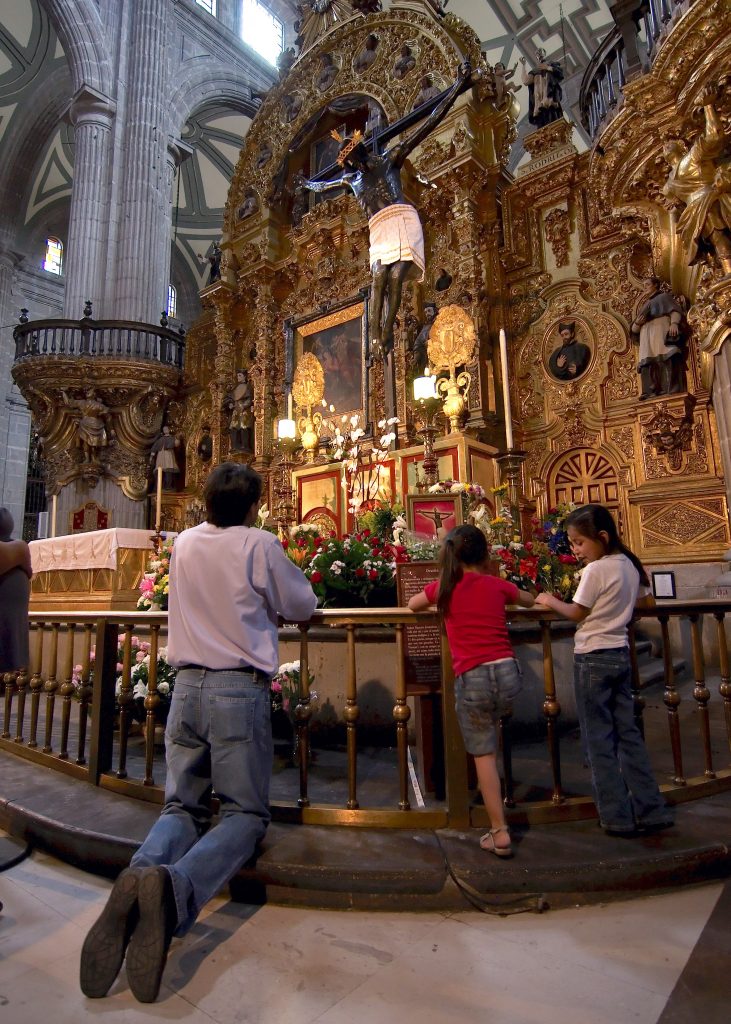The Cathedral of Mexico City is one of the greatest Christian churches in the world, probably the most outstanding in our hemisphere. Three centuries in the construction and decoration, it is an anthology of art and devotion.
You could make a retreat just focusing on the 16 side chapels, the sacristy, which would put some modern churches to shame, and the high baroque altars, the main one called “Altar de los Reyes” (“Altar of the Kings”) and the “Altar de Perdón” (“Altar of Pardon”), at the entrance of the cathedral.
The “Altar de Perdón” was indulgenced especially for prayers for the dead. In front of that altar is a crucifix called “El Señor del Veneno” (“The Poisoned Lord”).
This crucifix was made by indigenous artisans in the 18th century. It is unusual for its deep black color and for the way the corpus of Christ hangs in a y shape. Jesus seems to be bending his knees, and that has inspired legends about the sculpture and some very theological reflection.
There are several different versions of those legends, but two of them speak a great deal to me.
The first emphasizes the location of the crucifix in the chapel of the Dominican seminary called “Porta Caeli” (“Heaven’s Gate”). The story has it that a priest heard the confession of a man there who had stolen a treasure and in the process murdered someone.
The priest said he could not give absolution unless the man returned the treasure and submitted to justice for the homicide. The man was repentant but not that remorseful, apparently.
He regretted having confessed his crime and then, ignorantly, supposed the priest would report him to the authorities. A priest cannot break the seal of confession even when he refuses absolution.
Because he felt threatened with exposure, the man decided to kill his confessor. The priest had the pious custom of praying before and then kissing the crucifix before retiring each night from the chapel.
The murderer knew of the practice and so smeared the feet of the corpus of Jesus on the cross with poison. Supposedly, the criminal hid in the shadows of the darkened church in order to watch the deadly kiss.
As the priest leaned down to kiss the image, the murderer was shocked to see the body of the Christ shift on the cross and swing his feet away from the priest’s face. The legs supposedly then remained in that position, saving the priest. Some say the murderer repented and others that he ran away frightened.
For me, this story has many lessons: about the seal of confession, the necessity of true repentance, and reparation from sin and the value of pious veneration of images of the Lord.
The other story says the image was not always so dark but that it absorbed the poison painted on the feet and changed color all the way to the head. Those with devotion to this crucifix see the image as absorbing the poison of their lives, all the moral darkness of sin and suffering.
On my visits to the cathedral I have always seen people praying before the crucifix with great reverence and concentration. “I beg you, Lord,” says a prayer connected with the image, “to purify me so that the vicious poison of sin not penetrate my heart.”
Last year, the sculpture made of a kind of paste from sugar cane was given a protective restoration treatment. Many faithful were very concerned about the absence of the crucifix, and the cathedral’s art director had to make a statement about preserving the image for the veneration of generations to come.
He also said that the contributions of those who are devoted to the Black Christ are the most important source of economic support for the great cathedral. “ ‘El Señor del Veneno’ sustains the cathedral financially,” he said. (Body and soul, brick and mortar and spirit — as a pastor, I can empathize).
In Latin American countries you can see many diverse people praying privately in the churches, not just in liturgies.
In Mexico there are centuries-old, very beautiful churches, with people old and young, men and women, kneeling in prayer, often with an absorption in their dialogue with God that would put many of us to shame. Even some of our most beautiful cathedrals and basilicas are not free of a touristy ambience sometimes.
In the Cathedral of Mexico City one experiences sacred space made beautiful not only by centuries of art but also by the hallowing of the prayer of countless generations of poor and humble people.
The Black Christ, the Lord poisoned by our sin, has inspired so much prayer and consolation. As is evident in this example, it is a prayer more filled with sentiment than we are accustomed to in Anglo culture, a prayer that is the poetry of the soul.
I know that for you nothing is impossible
My beloved Lord who was poisoned
I ask you from the deepest part of me,
With the deepest confidence in your power
Help me in my anguish and lack of peace,
I ask you with all my faith and hope
That you help me in my great difficulties.
Let me climb your cross and get next to you
To receive your mercy and blot out my past errors,
To live free of fears and avoid the death of sin.
Give me your blessing and favor, my beloved crucified Lord.
Amen.
Msgr. Richard Antall is pastor of Holy Name Church in the Diocese of Cleveland, a contributor to Angelus and author of the book “Jesus Has A Question for You” (Our Sunday Visitor, $11.95).
SPECIAL OFFER! 44 issues of Angelus for just $9.95! Get the finest in Catholic journalism with first-rate analysis of the events and trends shaping the Church and the world, plus practical advice from the world’s best spiritual writers on prayer and Catholic living, along with great features about Catholic life in Los Angeles. Subscribe now!

